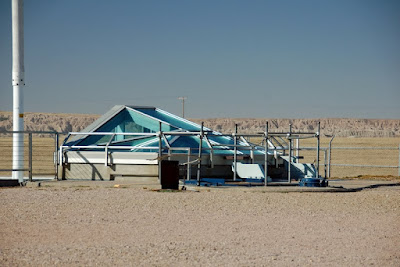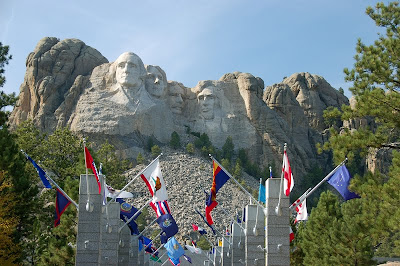We have arrived in North Dakota as of Sunday evening. A long drive, and the sight of huge rolls of hay will be my first thoughts of North Dakota from now on. Lots and lots of hay up here! Monday morning we checked in with the representative from Express Employment, our recruiter, to do the hiring paperwork and view the orientation video. From there we were sent out to the Hillsboro site for training. We have been assigned to the Reynolds site, about 20 miles from the campground, which isn't too bad. It's farther than I would like to drive, but its better than the Ada site which is 40 miles from here! Campgrounds are few and far between out here. In fact, it is mostly farmland as far as the eye can see. Even the closest WalMart is 45 miles south of here, in Fargo. So we have stocked up for as many days as our fridge and pantry can hold, as once we start there won't be much time for shopping.
Tuesday we went back to the Hillsboro site for a full day of hands-on training on one of the piler machines. This is where we will be working. The piler is where the trucks full of sugarbeets come to unload their product. They pull in to either side of it, and then dump their trailer of beets into a hopper, where a conveyer shuttles them through the piler. While this is happening, my job is to go over to the driver, and collect his paperwork. The paperwork will tell me whether a sample is to be taken of his load. If yes, then I go over to the sampler, place a bag on the funnel, and hit "sample" button. A bucket then scoops some of the beets up and deposits them into the bag, which I then seal up and place in a collection area. While the beets are being shuttled along the conveyer, they are being shaken and sprayed down to remove the dirt from them. The company doesn't want to pay for the dirt as well as the beets! Once the load has been deposited, I then direct the driver to park under another conveyer, which will take the dirt that's been removed from the beets and return it into the bed of the truck. I then signal the driver he's clear to take off, and his truck is re-weighed at the scale house to determine the weight of the crop he just dropped off. Al was working with me for awhile, and then was "promoted" to pile operator...he actually worked in the control room of the piler. All in all, it wasn't rocket science, and once we got down the steps and I figured out how to grab the pencil stub for filling in the ticket with my gloves on, we were good to go :-). Now we're just hanging out, waiting for the harvest to officially begin, which supposedly will be October 1. It all depends on the weather, though. The temperature needs to be between freezing and 70 degrees, otherwise they can't harvest. Rain will also shut it down. We have heard, though, that the long-range forecast is pretty good, and that the harvest should be done within 2-3 weeks tops. That's a good thing, as I don't really want to work at this pace for too long. Its not hard, but the shifts are long, 12 hours, and go every day that the weather is good. And we've been assigned to the night shift, which is what we requested, as we feel the dogs will be better off cooped up in the trailer overnight by themselves, rather than during the day.
Well, enough about that for now. How about some pictures? We spent two days in the Badlands National Park before heading this way. Very interesting place! I felt as if I had driven right into a moonscape of some kind. When we left Custer, we drove east towards the town of Interior, where we stayed at the KOA Badlands/White River campground, and elected to ignore the gps telling us to take the interstate. We drove through the Badlands on Highway 44, and it was really neat. After getting set up (it had only been a 2 hour drive), we drove up to the town of Wall, to see the famous
Wall Drug and find a grocery store. Definitely a tourist trap, and quite full of kitschy items. Actually, I'm glad we needed to find a grocery store and fuel, as Wall Drug itself really wasn't worth spending the 40 miles worth of fuel on by itself :-)!!
We did drive the Badlands Loop road back to the campground, and being later in the day the colors just seemed to pop from the formations.
The Loop Road roughly follows the Badlands Wall, a 60-mile long line of buttes that dominates the surrounding terrain. The story of the park's geology begins with shale that was deposited about 70 million years ago, and can be seen as a blackish layer at the bottom of some formations. Above that are layers of sandstone, volcanic ash, ancient soils and siltstone in shades of yellow, gray, brown and red.
The Yellow Mounds
The strata is clearly visible in these formations.
We walked a few trails in the park, one of which was this one, called the "Door Trail". A natural door was formed in the area
leading to the intricately eroded canyon. The erosion that sculpted Badlands National Park began only 500,000 years earlier than the present..geologically speaking, a very short time ago :-). The process continues today at a relatively rapid pace, with formations being worn away at an average of an inch a year. If conditions remain unchanged, visitors 500,000 years from now will be looking at a flat plain!
We also walked the Fossil Walk Trail. The Badlands have been a treasure trove of fossil deposits, revealing that some 26 million to 37 million years ago prehistoric mammals such as a hornless rhinocerous, a three toed horse, and a small saber-toothed cat roamed the area.
Modern day animals include the ever-present prairie dogs
and bighorn sheep
these dudes had some big curlies on them!
one very nicely posed for us :-).
These two are NOT native, but had a grand time!
It was just beautiful scenery everywhere you turned.
We also visited the Minuteman Missile National Historic Site while we were in the area. All I really remember from the Cold War is the "duck and cover" drills in elementary school. It was very interesting. South Dakota was one of the states chosen to host the force of a thousand Minuteman missiles. This was for two reasons. They were a weapon developed during the arms race between the Soviet Union and the United States, utilizing the policy of "mutual assured destruction". If either side pushed the button, the other would react, and we would both perish. Such MAD policy was seen as a deterrent to war. By locating the missiles in the northern Great Plains, they were closest to their targets, via the Arctic Circle, in the Soviet Union. The second reason was the relative low density of population....the missile sites themselves were a target, so if anything was shot their way, there were less people around to be killed.

The Park Service gives several tours daily on a first-come first-served basis of the Launch Control Facility Delta-01 and the underground launch-control center it supported.
This is the blast door entrance to the launch control center. two man crews manned the center around the clock.
This is the launch-command center. The two man crew stayed inside this container, 30 feet underground, waiting for the possibility of a command to fire the missiles. They controlled 10 missile silos from this center, the silos radiating around the center up to12 miles away. Someone asked how the crew would get out in case of an attack, and the answer was, if there was an attack, their job was to stay there and make sure the missiles were fired in retaliation. And if that happened, there wasn't anything left top-side to escape to. Thank goodness, the missiles never had to be fired!!
Eleven miles away is the second part of the tour, Launch Facility Delta-01, an actual missile silo.
An inoperative Minuteman missile is in the silo. This site you tour on your own, with a cellphone tour available that will guide you around the silo...on the outside. We then finished up our tour at the Visitor Center, looking at exhibits, viewing the movie, and talking with the ranger on duty. It actually was very interesting and informative, and didn't cost a dime!
Another drive through the park as the shadows were lengthening....see us there??
Sunset heralded the time to head back to camp, and pack up for the long drive to North Dakota.
I will definitely try to keep everyone updated on our beet adventures....our family is now calling us "beetniks" :-), but if you don't hear from us for awhile, rest assured, we are in the routine of work, eat, sleep and start over again!




























































